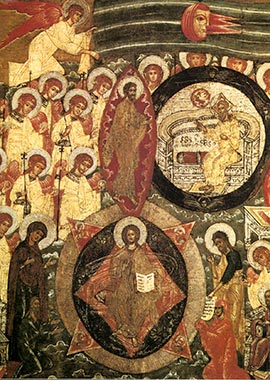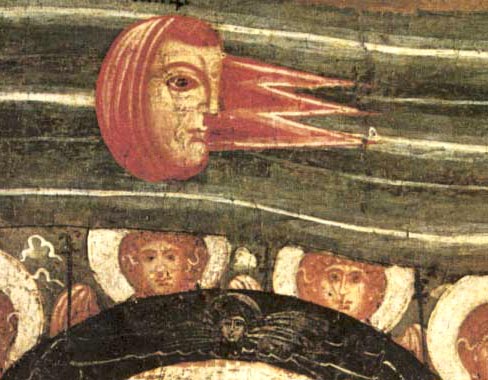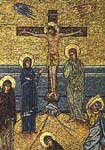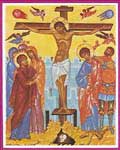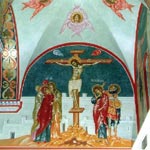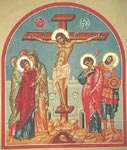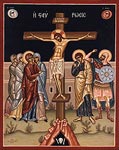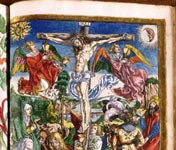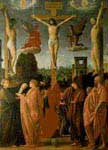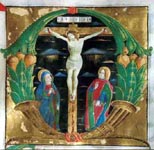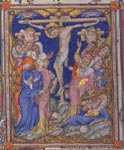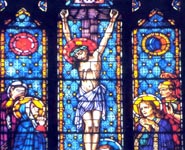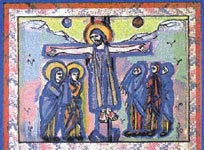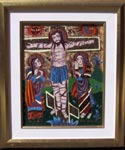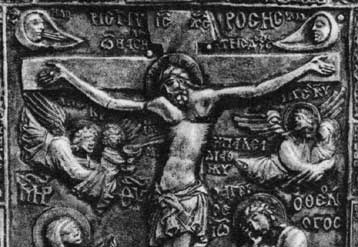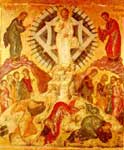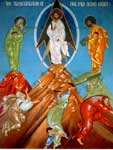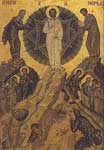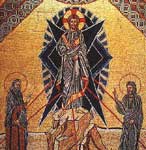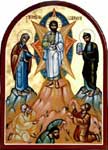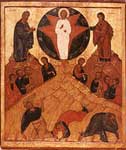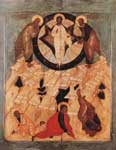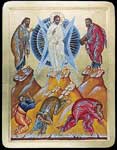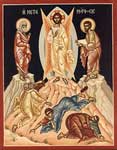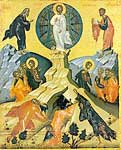Diego
Cuoghi
ART
and UFOs?
No thanks, only art...
CRUCIFIXION
Svetitskhoveli Cathedral, Mtskheta, Georgia
This bad picture, maybe taken from a magazine, appears in almost all the websites dedicated to the UFOs in art.
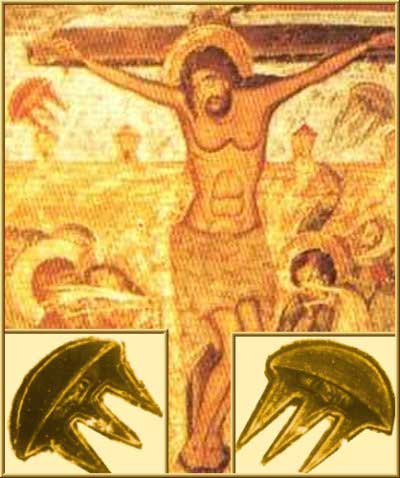
Here is a better picture in which we can see all the details
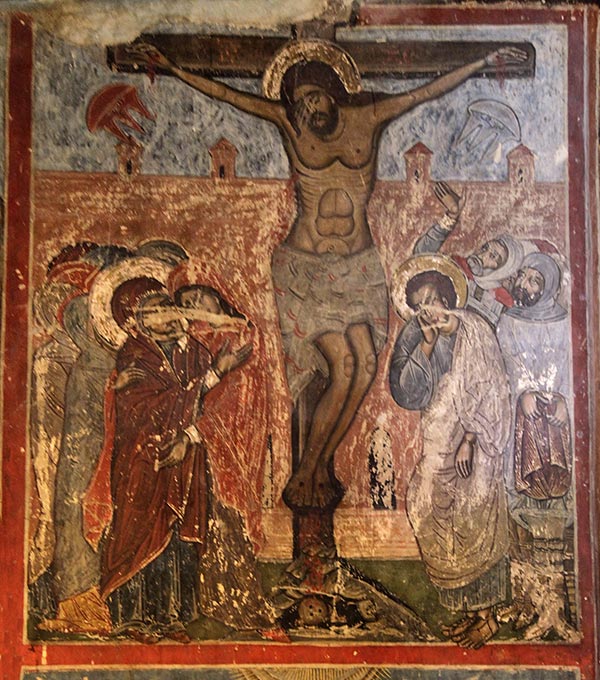
Photo: Steffen Schülein (GTA - Georgian Tourism Association )
This Crucifixion, located on one side of the grave of Sidonia in the Svetitskhoveli Cathedral of Mtskheta, Georgia, and is one of the most widely known cases of the misunderstanding of an artwork. But those who are familiar with symbolism in medieval art understand that there are no mysterious elements in this holy painting. In fact in the most of the crucifixions done in the Byzantine style show the same “objects” on either side of the cross. They are the Sun and the Moon, often represented with a human face or figure.
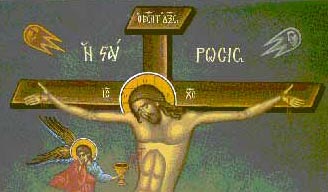
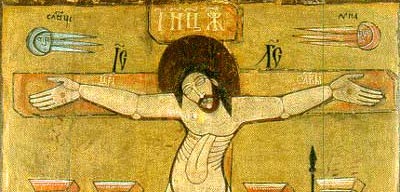
Here is a description of the scene surrounding the crucifixion in one Byzantine
painting:
"
At the top are four angels. One half-length pair, flanking the arms of
the cross, is in mourning. The other pair, above, is in flight. The angel
at
the top left introduces a bright female personification while gesturing toward
the sun. The opposite angel expels a dark personification to the other side
of the moon. This juxtaposition of light and dark, positive and negative,
is central to the interpretation of the panel as representing man’s
redemption through Christ’s death.” (http://www.st-mary-mons.org/english/ancient_icon_of_crucifixion_13th.htm)
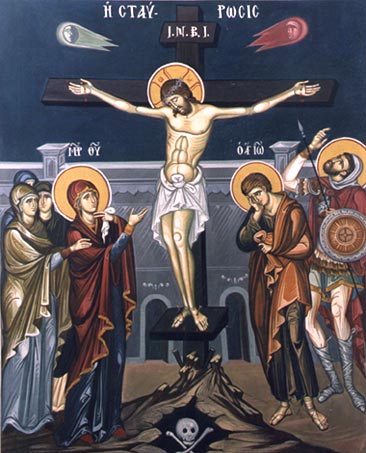
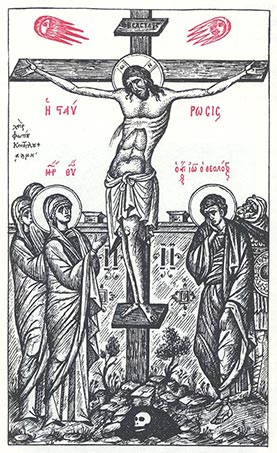
Here is a small sample of crucifixions in the Byzantine style, showing the Sun and the Moon with human attributes:
But not only in Byzantine Orthodox icons do we find the Sun and the Moon in Crucifixions. They are also found in the work of painters like Dürer, Crivelli, Raffaello, Bramantino, and in illuminated medieval manuscripts:
Some modern art examples :
Conclusions:
The Mtskheta Crucifixion contains no UFOs. The two objects near the cross are an anthropomorphic representation of the Sun and the Moon shown in much the same way as in many other Byzantine Crucifixions.
CRUCIFIXION
( Visoki
Decani Monastery, Kosovo)
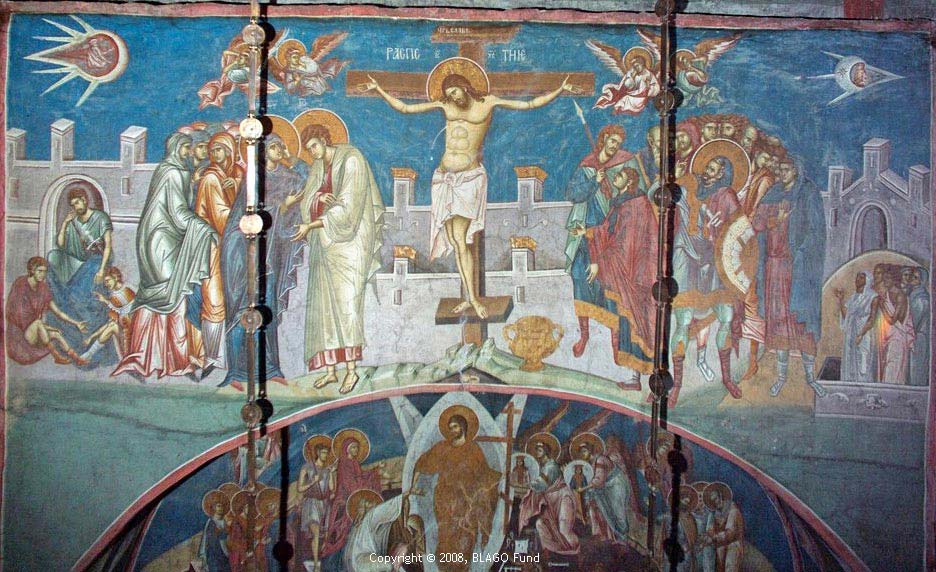
(photos courtesy of BLAGO Fund Archives, from http://www.srpskoblago.org)
This 14th century Crucifixion, a fresco in the Visoki Decani Monastery in Kosovo, is, like the previous one, considered a UFO-painting. The two strange objects at the sides of the cross are considered to be the UFOs:
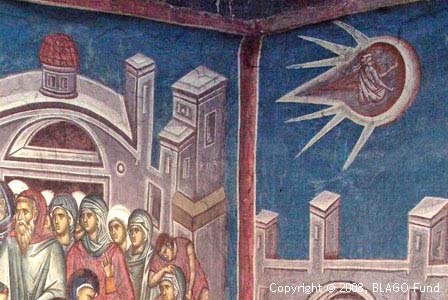
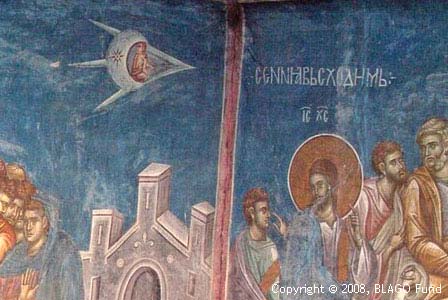
(photos courtesy of BLAGO Fund Archives, fromhttp://www.srpskoblago.org)


(photos courtesy of BLAGO Fund Archives, from http://www.srpskoblago.org)
This is one of the oldest documented UFO-in-art cases because the first articles about it were published in the sixties, in the French magazine “Spoutnik.” This fresco was “discovered” by Alexandar Paunovitch, a student at the Academy of Arts of Yugoslavie in 1964. After this early publicity, the pictures were featured in many books about UFOs. On many web pages we read that the two objects in the sky are, without any doubt, “spaceships with crew.”
But this Crucifixion also follows the common iconographic model of the Middle Ages. The “Deposition from the Cross” of Benedetto Antelami, in the Dome of Parma in particular resembles the Crucifixion of Visoki Decani:.
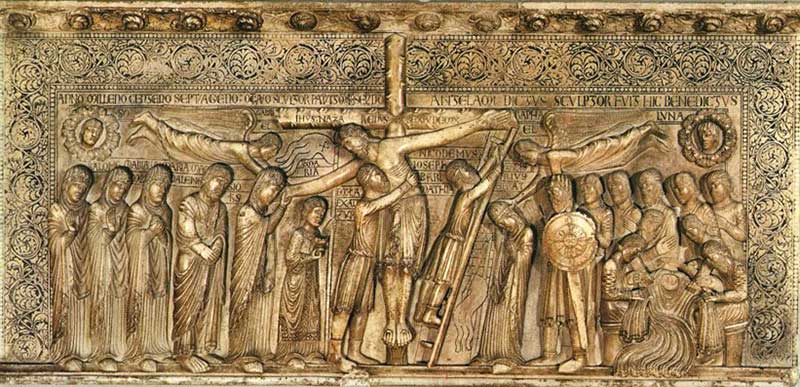
On the edges of the composition, in the same position as in the fresco of Visoki Decani, the Sun and the Moon are represented as human witnesses to the Crucifixion just as they are in the previous painting. In both art works the figures who represent the Sun and the Moon look towards the Cross that is located in the center of the composition.
The Sun and Moon, represented as human figures, are visible in many Byzantine-Orthodox sacred paintings, therefore as we have seen in the previous understood one it, dedicated to the Crucifixion of Mtskheta. Below a particular of an ancient Gospel (Treasure of Saint Clement, sec. XIV) and a modern byzantine fresco:
James Hall, author of the "Dictionary
of Subjects & Symbols In
Art" writes:
“
The sun and moon, one on each side of the cross, are a regular feature
of Medieval crucifixions. They survived into the early Renaissance but are
seldom
seen after the 15th century. Their origin is very ancient. It was the custom
to represent the sun and moon in images of the pagan sun gods of Persia and
Greece, a practice that was carried over into Roman times on coins depicting
the emperors.”
(...) The sun is[sometimes represented as simply a man’s bust with
a radiant halo, the moon as a woman’s with the crescent of Diana.
Later they are reduced to two plain disks, the moon having a crescent within
the
circle, may be borne by angels. The sun appears on Christ's right, the moon
on his left.”
Two ivories from the Museé de Cluny, Paris, the Sun and the Moon are on sides of the cross:
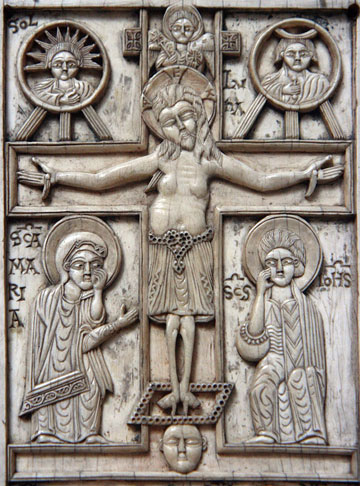
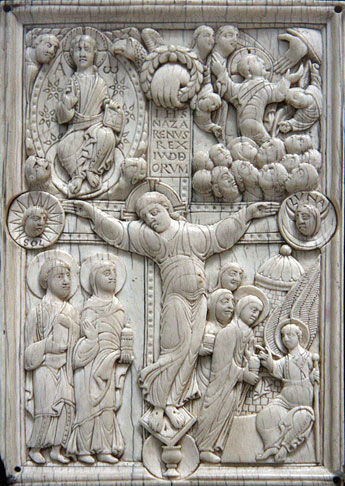
Often, the Sun and the Moon were represented as human characters driving wagons drawn by horses and by oxen, as in this ivory bas-relief , the binding of the "Book of Pericopi of Henry II " from XI century (München, Bayerische Staatsbibliothek):
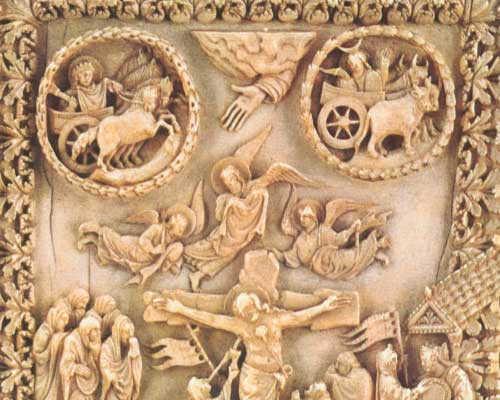
A sculpture by Benedetto Antelami in the Dome of Parma, with the story of Barlaam and Josafat, where the Sun and the Moon appear to be "doubled" in the figures of the fighting Day and Night.:
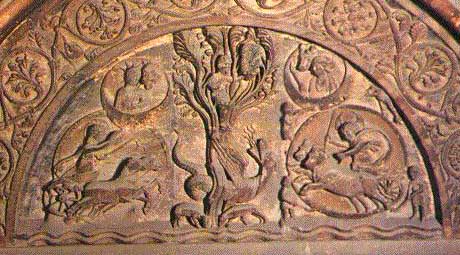
In the same Decani Monastery, in a lower level vault, there are other depictions of the "humanized" Sun and Moon:
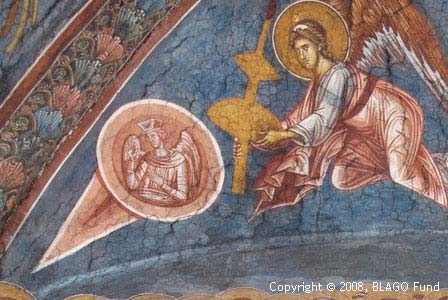
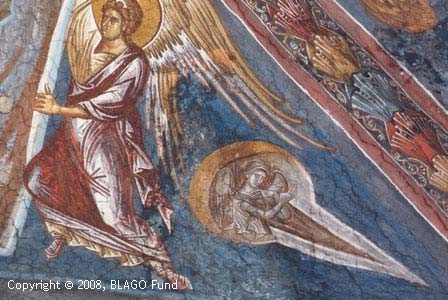
Conclusions:
In the Visoki Decani Crucifixion fresco there are no UFOs. The two objects near the cross are anthropomorphic symbols of the Sun and the Moon, represented in much the same way as they are in many other Byzantine Crucifixions.
![]()
Arte bizantina, Trasfigurazione di Cristo
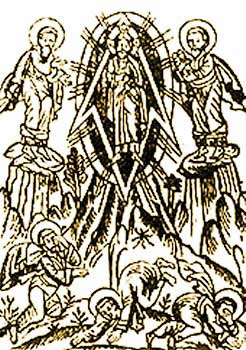
Anche questa immagine viene interpretata
in senso ufologico in molti siti web. Questo è il commento che si
legge nelle pagine di Edicolaweb: «Affresco
del Quattrocento visibile a Kiev, ove è chiara la rappresentazione
di Gesù dentro un razzo in movimento di ascesa, sorretto da due
angeli in piedi su due nuvole che si muovono in sintonia verso l’alto,
con tanto di scia a evidenziarne il movimento ascensionale.»
Sarebbe bastato aprire i Vangeli
e leggere la descrizione di questa scena per capire il soggetto del disegno.
Ecco la Trasfigurazione descritta nel vangelo secondo Marco:
«Dopo sei giorni, Gesù prese con sé Pietro,
Giacomo e Giovanni e li portò sopra un monte alto, in un luogo appartato,
loro soli. Si trasfigurò davanti a loro e le sue vesti divennero
splendenti, bianchissime: nessun lavandaio sulla terra potrebbe renderle
così bianche. E apparve loro Elia con Mosè e discorrevano
con Gesù. Prendendo allora la parola, Pietro disse a Gesù: «Maestro, è bello
per noi stare qui; facciamo tre tende, una per te, una per Mosè e
una per Elia!». Non sapeva infatti che cosa dire, poiché erano
stati presi dallo spavento. Poi si formò una nube che li avvolse
nell'ombra e uscì una voce dalla nube: «Questi è il
Figlio mio prediletto; ascoltatelo!». E subito guardandosi attorno,
non videro più nessuno, se non Gesù solo con loro. »
E anche in questo caso si tratta di una raffigurazione in stile bizantino, ripetuta da secoli in modi pressoché identici:
Questa ultima immagine viene dalle pagine web di una chiesa ortodossa americana:
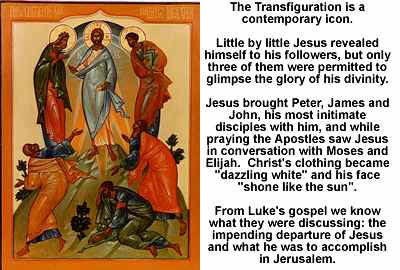
Conclusions:
In the image called "Kiev fresco" there are no UFOs or rockets. It is simply a representation of the "Transfiguration" of Jesus in bizantine style, similar to every other Orthodox Tranfiguration icons.
I MISTERI DELLA MAPPA DI PIRI REIS
